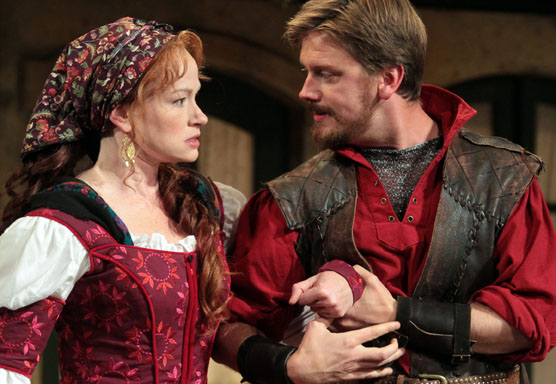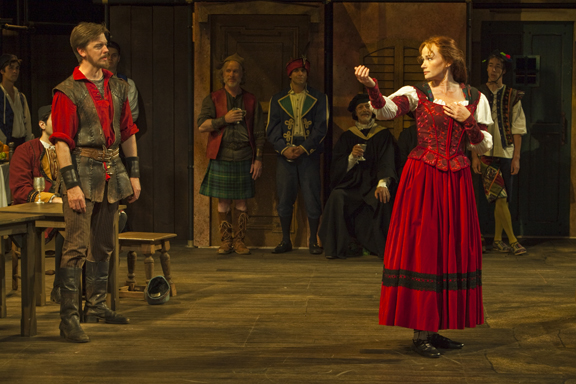REVIEW: TAMING OF THE SHREW at Shakespeare Santa Cruz
August 17, 2013 § Leave a Comment
The Green World
A recurrent pattern in Shakespeare’s comedies, what Northrop Frye called the “Green World” comedies, is “a journey from the “normal world,” into an alternate (often somewhat mystical) place engendering a metamorphosis. . . and then a return to a now renewed original location. We see this pattern in As You Like It, Twelfth Night, and, especially, in Midsummer Night’s Dream.
I’ve never thought of The Taming of the Shrew as a “Green World” comedy, but Edward Morgan’s production for Shakespeare Santa Cruz treats it as one and by doing so reveals interesting new aspects of the play, while taming its great, central challenge.

Kate (Gretchen Hall) wonders whether Petruchio’s (Fred Aresenualt) marriage intentions are true in Shakespeare Santa Cruz’s 2013 production of THE TAMING OF THE SHREW. Photos courtesy of Shakespeare Santa Cruz.
Shrew as a Problem Play, (or really just a problem)
The genre designation of Shrew is now, notoriously, unstable. It is structurally a comedy, but we no longer find the spectacle of a high-spirited woman being humiliated and starved into subjugation as funny. It is hard to produce it in a satisfactory way.
Contemporary productions attempt to get around this problem in a number of ways. The least satisfactory, but extremely common, solution is to treat the play as a combination of fairytale and farce, with no more real world implications than Roadrunner vs. Coyote.
A more sophisticated one is to undercut the message ironically, often changing the relationship of the principle couple from adversaries to secret co-conspirators. That can be very interesting, although it is accomplished by undercutting the text with contradictory behavior and line readings for a great deal of the show. I reviewed a production earlier this summer that took the latter approach successfully.
More than a few modern productions simply throw in the towel and abandon any pretense to comedy. They explore the dark underbelly of the play and let the resolution be the tragic destruction of its heroine.
The Santa Cruz Solution
Morgan’s production restores the comedic resolution in quite a novel, but quite complex, way. It is set up from the very first moments of the play, or before actually, when the cast wanders freely about the audience and onto the stage improvising around material excerpted from Shakespeare’s “induction” scene. Rarely seen in the modern theater, the “induction,” or introduction, is a sub-plot involving a town drunk named Christopher Sly. In the Folio text, he is fooled by an elaborate charade into believing he is a great lord, for whom the main play is being presented, and then – once it is underway – mysteriously disappears never to return.
The Santa Cruz production borrowed only a few lines and a bit of this subplot, but retained the detail that Sly sinks into a dreamlike stupor as the main action is beginning, in this case, downstage center on the suddenly abandoned stage.* This was related to, if not caused by, the surreal arrival of a harlequin-esque servant, Biondello (played by Andrew P. Quick), apparently kayaking – sans kayak – through the air. Sly watched a short bit of the ensuing action in which Biondello’s master, a wealthy, young Lucentio (amiably personated by Elvin McRae) arrived in town to study and have some fun. Upon realizing that the newcomers didn’t see or react to him, Sly turned to the front rows through which he was stumbling away and asked pointedly, “Am I dreaming?”
Confirmation that he was dreaming came quickly, when the same actor (the brilliant Fred Arsenault) arrived back onstage as the play’s protagonist, Petruchio. As is implied by the now common doubling of Theseus/Oberon as dream doppelgangers in Midsummer, this Petruchio was still in Sly’s clothes, but was a more powerful, successful, and confident version of him – his dream self.
Look and Feel
For much of the ensuing action, while Petruchio first woos, then weds, and finally tames the fiery Kate, the production seemed rather conventional – even old-fashioned. A director’s note tells us that the production is set, not in Padua, but in 15th Century Galacia (now a part of Spain), but it was hard to see a sharp distinction from the prototypical setting of Renaissance Italy in anything more than a bit of local color in B. Modern’s costumes. It looked and sounded like the broad comedy the play was once held to be.
The antagonist/female lead, Kate, played by Gretchen Hall, was a great deal meaner and more unsympathetic than most – the logic of which eventually became clear, as will be explored below. V Craig Heidenreich, playing Baptista, father to both Kate and a much-sought-after, mild-mannered daughter named Bianca (played by Victoria Nassif), not only looked a great deal like John Lithgow, but openly imitated his famous dead-pan, falling delivery. Petruchio’s servant, Grumio, (Conan McCarthy) was kilted and hard-drinking. Gremio, one of Bianca’s suitors, was played very broadly by local staple Kit Wilder, earning most of his laughs through funny sounds added to the ends of his lines. William Elsman played Hortensio as a more plausible third suitor for Bianca than is typical, but none of these characterizations were particularly nuanced or dimensional. Generally speaking, then, it seemed it was to be a thoroughly conventional, if lightweight, production.
Always Watch Out for the Bits that Don’t Fit
Only a couple of features truly stood out from the overall tone. First, the Puck-like Biondello was unusually prominent, and stood outside the world of the play. His actions were undertaken with literal winks and nods to the audience, and frequent deliveries of messages seemed less like missives conveyed, as assigned in the plot, than as mystical, perhaps magical, interventions to move Petruchio’s fortunes forward.
More importantly, Petruchio was a more mythic than comedic hero. He was thoroughly mercenary in pursuit of his marriage, but what was most striking was how easily successful he was at everything. A telling detail, for example, was that during a short bit of his first scene when someone else had the floor, he knocked at the window of a nearby house which opened and he was handed a drink without even having to request it. His status was made explicit when he arrived at his wedding dressed as a folk version of Piccasso’s Bull-man awaiting the maiden sacrifice. Both Petruchio’s soliloquies were beautifully rendered as confessions that he did not know if what he was doing was the right thing, but fate seemed to be pulling him forward. He seemed no less amazed than anyone else at his wife’s complete transformation in the final scene of the play where he has bet on her obedience, against Lucentio, who won Bianca, and his friend Hortensio, who lost Bianca, but married a rich widow as a consolation prize. Her heartfelt delivery of Kate’s famous monologue admonishing women to be subservient to their husbands (their lords, kings, and governors – as she says) was every man’s dream, especially considering that she had been his – apparently literal – nightmare for most of the play.

Petruchio (Fred Arsenault) is stunned by Kate’s final speech (Gretchen Hall) in Shakespeare Santa Cruz’s 2013 production of THE TAMING OF THE SHREW.
A Dream with No Bottom
Well, maybe not every man’s – but it was specifically Christopher Sly’s dream. In an ending that appears to have been suggested by a play called The Taming of A (as opposed to THE) Shrew – a play with a complicated, ambiguous relationship to Shakespeare’s play – when the stage cleared for what we thought might be the final time, instead we watched Petruchio transform back into a drunken Sly. (In A Shrew, the precise action is that Sly awakes, in a manner very reminiscent of Bottom in Midsummer, to the realization that he has been dreaming, and that his dream was a revelation. He heads home determined to tame his wife.)
In Santa Cruz’ simpler, cleaner rendering, suddenly it was clear that the play had, literally, been a male fantasy – presided over by a trickster Biondello, – and that Sly must now interpret it.
Biondello, reversing the opening, air-kayaked off into the wings. Sly was left alone – drunk, dazed and confused when (in an entirely invented scene, although pieced together out of dialogue from the induction materials in both THE and A Shrew) his wife, played by the same actress who had played Kate, arrived to fetch him home. The pitiful reality that she must pay his bill, and half-carry him home, seemed humiliating. Sly would not be moved, however, and instead (repeating a scene from the play between Petruchio and Kate) demanded to be kissed. As Kate did, his wife demurely rejected a public display of affection. As Petruchio did, Sly boldly asked, “What? Art thou ashamed of me?”
We know that the answer should be yes, but something was transformed in Sly because of his dream, and his wife saw in him a spark (of self-respect? of desire? of understanding?) that had not been there for a long time. She kissed him, her anger dissipating, and gently escorted him from the stage.
It was a genuinely affecting ending, reversing the power structure of the main play, but repeating its thematic exploration of how couples find, or create, compassionate marriages. Afterwards, I overheard a comment to the effect “that was not Shakespeare’s Shrew.” Knowing where his writing would soon go in his Green World comedies, I say, maybe not, but it sure was Shakespearean.
*Because the program notes do not discuss the textual decisions, it is impossible to tell whose ideas are at work, but the production’s textual consultant and dramaturg is the brilliant Shakespearean scholar, Michael Warren. It is a good guess that his insight might lie behind this highly original arrangement of the text. (It may have been a good guess, but turned out to be wrong. See note below.)
UPDATE: Director Edward Morgan has responded to this review to clarify that the final scene, although in the location and serving the purpose of the induction materials from A SHREW, was entirely drawn from the text of Shakespeare’s THE SHREW. He also clarified that the concept for this final scene was his, not Warren’s. I appreciate his taking the time to read and respond, and am hereby clarifying my own review. I have also made minor changes to the earlier text.